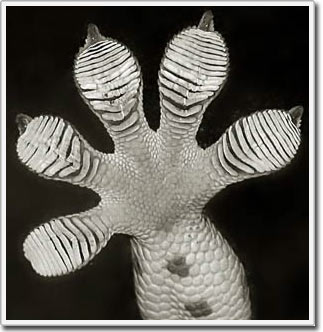Gecko feet form the idea for biodegradable medical bandages
MIT researchers and colleagues recently created a waterproof, sticky bandage with the idea of geckos. This tape can replace stitches and pins to become a basic tool in surgical rooms that can cause internal or surgical injuries to heal.
Based on the grounds that the gecko feet 'feet become unique, the surface of the bandage also has floating lines and grooves with a nano-scale like on a gecko leg that helps them cling to walls and ceilings. . Covered on the surface of the tape is a thin layer of adhesive that helps it stick in wet environments, such as hearts, bubbles or lungs. And since the bandage is self-destructive, it will gradually dissolve, no need to remove it as before.
The research team was led by MIT Institute professor Robert Langer and Jeff Karp (medical assistant at Brigham, at the Women's Hospital, Harvard Medical School). Both are members of the Harvard-MIT specialty in Health Sciences and Technology (HST).
Karp said: 'We need medical tape now.' For example, sticky surgical tape is made of new material that can wrap around and shield the intestine after cutting the infection, or after performing a gastric surgery, for example. It can also patch wounds caused by ulcers . Because it is easy to fold and fold into the bandage, it can be used in microscopic surgeries where it is difficult to perform stitches.

The feet of the Tokay gecko have sticky pieces.Gecko feet have the ability to adhere even when they hang upside down or on vertical surfaces.This gave rise to the idea of creating a new medical band for the MIT research team.(Photo: David Clements via Wikimedia)
Gecko-like dry-type adhesives have been around since 2001, but there are still many challenges to apply the technology to medicine due to the strict and demanding requirements of its design criteria. . In order to be used inside the human body, they must be bonded in humid environments and must be made up of specialized materials used in medical applications. Such materials must be biologically appropriate, meaning that they do not cause inflammation, decomposition (gradual dissolution in the environment without being toxic), and elastic to be suitable for them. tissue in the body.
MIT researchers have met these requirements by creating medical adhesives thanks to ' bio-rubber ' developed by Karp, Langer and other scientists. They used micromachining - the technology used in computer chip design - to shape bio-rubber into diverse folds and grooves in nanoscale. After testing this adhesive material on intestinal tissue taken from pigs, scientists have found the best adhesion pattern. It is a piece of ice with long column-like lines arranged large enough to adhere to the underlying tissue.
Karp then added a very thin layer of glue made from sugar to better bind even when applied to a wet surface. Karp said the finished piece of medical bandage 'is really something we don't want to remove' because of its difference, he continued: 'We don't mimic geckos with feet. Adhesion but can still lift up to go. We took the idea of geckos to create a detailed surface to increase the surface contact area, thereby increasing the general adhesive ability '.
When the test was repeated on pig intestinal tissue, the nanoparticle's binding ability was twice as large as the adhesive without vignettes. In the new binder tests performed on mice, the glue-coated nano detail adhesive increased the ability to stick to 100% compared to the same non-coated material. Moreover, the experimental mice were only slightly swollen when using this adhesive, which is a negligible reaction when used in the treatment of diseases.
Besides other benefits, the adhesive can release pharmaceuticals when biodegradable rubber pieces . Moreover, the elasticity and decomposition rate of bio-rubber can be adjusted due to the surface with many column-shaped lines. That means new adhesive materials are created with the elasticity, elasticity and adhesion ability appropriate for each type of medical application separately.
Langer said: 'This is a very interesting example of how nanostructures can be controlled. And so we create a whole bunch of adhesive materials. '
The study was explained in February in the Proceedings of the National Academy of Sciences. Other MIT authors of the article are also the first co-authors including: Alborz Mahdavi (former MIT lab technician at Coimbra University - Portugal), Jason W. Nichol and Edwin P. Chan ( post-doctoral student HST), David JD Carter and Jeff Borenstein (Draper lab), Chris Bettinger (students are studying doctoral HST), and MIT fellows: Siamrut Patanavanich, Loice Chignozha, Eli B. Joseph, Alex Galakatos and Seungpyo Hong ( all in the chemical engineering department ). Other authors came from Massachusetts General Hospital and University of Basel - Switzerland.
The research was funded by the National Institutes of Health, Scientific Materials Research and Technology Center (MRSEC), the program of MIT National Science and Technology Foundation - Portugal.
- Medical bandages have the ability to heal wounds by ... sucking bacteria
- Reusable and self-cleaning tape is inspired by gecko feet
- Garbage in the universe with robots simulating gecko feet
- New generation bandages from marine algae can stop internal bleeding in minutes
- Marvel at the form of
- Decode the anti-slip mechanism of gecko feet
- Self-cleaning adhesive inspired by gecko feet
- Future personal tapes can track wounds and legends as needed
- Unknown things about the world of geckos are amazing
- Adhesive cushion inspired by gecko foot
- What is biodegradable bag?
- Discover new species of gecko in Vietnam
 Green tea cleans teeth better than mouthwash?
Green tea cleans teeth better than mouthwash? Death kiss: This is why you should not let anyone kiss your baby's lips
Death kiss: This is why you should not let anyone kiss your baby's lips What is salmonellosis?
What is salmonellosis? Caution should be exercised when using aloe vera through eating and drinking
Caution should be exercised when using aloe vera through eating and drinking